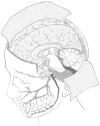Neurovascular pains: implications of migraine for the oral and maxillofacial surgeon
- PMID: 18343327
- PMCID: PMC2467394
- DOI: 10.1016/j.coms.2007.12.008
Neurovascular pains: implications of migraine for the oral and maxillofacial surgeon
Abstract
Epidemiologic studies have shown that migraine headaches are a common finding in the general population, often associated with a high degree of disability. Additionally, migraine has a reported comorbidity with other medical conditions, most notably with chronic pains, such as temporomandibular disorders. The pathophysiologic mechanisms involved with migraine are suggestive of an increased and prolonged hyperexcitability to stimuli, especially within the trigeminal distribution. Because migraine is mediated by branches of the trigeminal nerve it has the potential to mimic other types of pains, such as toothache or sinusitis. It is therefore recommended that oral and maxillofacial surgeons be familiar with the diagnostic criteria for migraine headaches to identify and appropriately treat such individuals who present to their clinics.
Figures





References
-
- Graham JR, Wolff HG. Mechanisms of migraine headache and action of ergotamine tartate. Arch Neurol Psychiatry. 1938;39:737–763.
-
- Moskowitz MA. The neurobiology of vascular head pain. Ann Neurol. 1984;16(2):157–168. - PubMed
-
- Woods RP, Iacoboni M, Mazziotta JC. Bilateral spreading cerebral hypoperfusion during spontaneous migraine headache. N Engl J Med. 1994;331(25):1689–1692. - PubMed
-
- Scher AI, Stewart WF, Lipton RB. Migraine and headache: A meta-analytic approach. In: Crombie IK, Croft PR, Linton SJ, LeResche L, Von Korff M, editors. Epidemiology of Pain. Seattle: IASP Press; 1999. pp. 159–170.
-
- Rasmussen BK. Epidemiology of migraine. In: Olesen J, Goadsby PJ, Ramadan NM, Tfelt-Hansen P, Welch KMA, editors. The Headaches. 3. Philadelphia: Lippincott Williams & Wilkins; 2006. pp. 235–242.
Publication types
MeSH terms
Grants and funding
LinkOut - more resources
Full Text Sources
Medical

